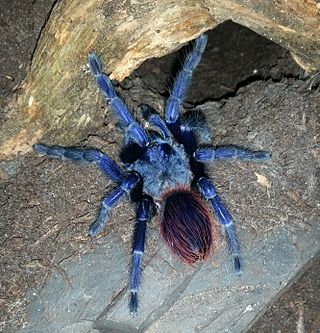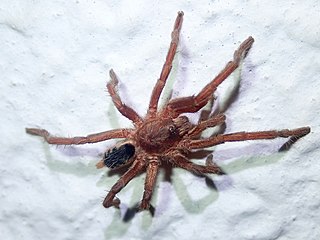
Avicularia is a genus of the family Theraphosidae containing various species of arboreal tarantulas. The genus is native to Panama, the Caribbean and tropical South America. Each species in the genus has very distinguishable pink foot pads.

Tarantulas comprise a group of large and often hairy spiders of the family Theraphosidae. As of August 2022, 1,040 species have been identified, with 156 genera. The term "tarantula" is usually used to describe members of the family Theraphosidae, although many other members of the same infraorder (Mygalomorphae) are commonly referred to as "tarantulas" or "false tarantulas". Some of the more common species have become popular in the exotic pet trade. Many New World species kept as pets have setae known as urticating hairs that can cause irritation to the skin, and in extreme cases, cause damage to the eyes.

Ischnocolus jickelii is a small, old-world tarantula. It is found in Aden, Djibouti, Ethiopia, the United Arab Emirates and Somalia. It was first described by Ludwig Koch in 1875. In 1890, French arachnologist Eugène Simon described Chaetopelma adenense. In 2008, José Guadanucci and Richard C. Gallon decided that these were the same species, making Simon's Chaetopelma adenense a synonym.

Cyriopagopus is a genus of southeast Asian tarantulas found from Myanmar to the Philippines. As of March 2017, the genus includes species formerly placed in Haplopelma. It was first described by Eugène Louis Simon in 1887.
Sickius is a genus of tarantulas. It has a single species, Sickius longibulbi. It is endemic to Brazil.
The Ischnocolinae are a problematic subfamily of tarantulas. In 1892, Eugène Simon based the group, which he noted was only weakly homogeneous, on the presence of divided tarsal scopulae. This feature was later considered to be plesiomorphic, and both morphological and molecular phylogenetic studies have shown that, as traditionally circumscribed, the subfamily is not monophyletic. A much more narrowly defined Ischnocolinae sensu stricto was proposed in 2014. One of the authors of that proposal subsequently said that no further taxonomic changes should be considered until there had been a more comprehensive sampling of the subfamily. As of January 2021, the status of the Ischnocolinae remains unresolved.
Catumiri is a genus of South American tarantulas that was first described by J. P. L. Guadanucci in 2004. The name is derived from the Tupi "Catumiri", meaning "very small".

Chaetopelma is a genus of tarantulas that was first described by Anton Ausserer in 1871. They are found in Africa including the countries of Turkey, Syria, Egypt, Cyprus, Greece, Sudan and Cameroon.

Ischnocolus is a genus of tarantulas that was first described by Anton Ausserer in 1871. This tarantula genus includes some of the smallest in the family.

Pterinopelma is a genus of Brazilian tarantulas that was first described by Reginald Innes Pocock in 1901. As of May 2020 it contains three species, found in Brazil: P. felipeleitei, P. sazimai, and P. vitiosum. It was removed from the synonymy of Eupalaestrus in 2011.
Tmesiphantes is a genus of Brazilian tarantulas in the subfamily Theraphosinae that was first described by Eugène Louis Simon in 1892. The genera Magulla and Melloleitaoina were brought into synonymy in 2019.
Trichopelma is a genus of South American and Caribbean tarantulas first described by Eugène Simon in 1888.

Guyruita is a genus of South American tarantulas that was first described by J. P. L. Guadanucci in 2007.
Schismatothele is a genus of South American tarantulas that was first described by Ferdinand Anton Franz Karsch in 1879.

Neoholothele is a genus of tarantula, first described in 2015 by Guadanucci & Weinmann. As of August 2022, it contains 2 species Neoholothele fasciaaurinigra and Neoholothele incei, the latter being the type species. They are named after the prefix "neo" from the greek word for new, and the genus Holothele.
Rick C. West is a Canadian arachnologist and an expert on the taxonomy of tarantula spiders. West was born in Victoria, British Columbia. He has been interested in spiders since childhood, and collected his first tarantula, Aphonopelma eutylenum, at the age of 13. He worked primarily as a Chief Constable for a local Animal Humane Society, but also have been involved with the collecting, breeding, rearing and photography of theraphosid spiders. West has traveled to over 27 countries to document and study them in their environment, has been a host, presenter and co-producer in several tarantula documentaries and has also described several genera and species.

Guyruita cerrado is a species of spider in the genus Guyruita. The species has originally been described by José P.L. Guadanucci, Sylvia M. Lucas, Rafael P. Indicatti and Flávio U. Yamamoto.
Spinosatibiapalpus is a genus of tarantulas erected by Gabriel and Sherwood in 2020 for a newly discovered species and two other previously described species bearing a unique palpal bulb morphology. The name is a reference to the spines found on the fourth section of the pedipalp in adult males. This distinctive feature was also found in Pseudhapalopus species, but because it is never mentioned in the original description of that genus, Gabriel and Sherwood called into question the validity of Pseudohapalopus, and moved all its species except P. aculeatus, known only from a single male found in Bolivia in 1907. It is impossible to place P. aculeatus because the holotype was destroyed when the museum housing it was bombed during World War II, and it has been declared as nomen dubium.
Yanomamius is a genus of South American tarantulas first erected by Rogério Bertani and M. Q. Almeida in 2021 for two newly discovered species and one previously described species from Brazil. In one of Bertani's prior studies, he investigated a tarantula collected by the Yanomami as a source of food. Based on the limited material available for study- two adult females and one immature spider- the species was placed into Holothele. The next year, it was moved to newly erected genus Guyruita due, in part, to the multi-lobed shape of its spermathecae. When the first male was found and described, the diagnostic characteristics didn't match that of Holothele or Guyruita, so a new genus was erected for Y. waikoshiemi and three other closely related species.
Ischnocolus vanandelae is a tarantula species in the Ischnocolus genus, it is found in Oman, and Iran, it was first described in 2020 by Vivian M. Montemor, Rick C. West, Alireza Zamani. This spider is named after Mrs. Priscilla M. J. van Andel, a Dutch wildlife enthusiast, who first collected this species with her husband Mr. J. H. Hans Raaijmakers.







